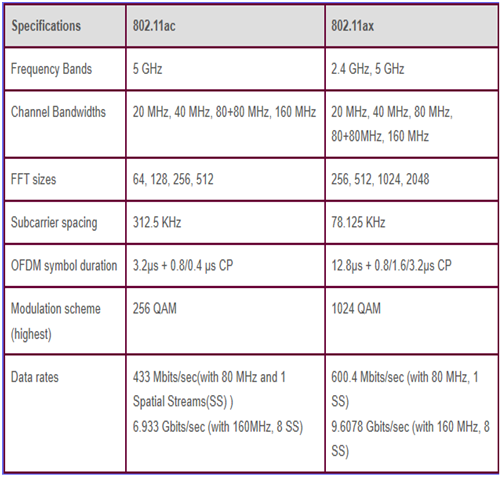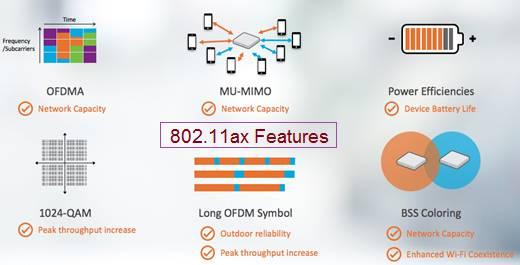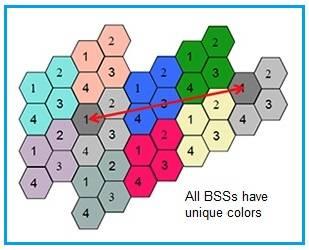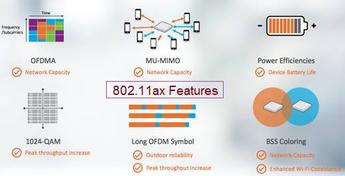10 WiFi 6 (802.11ax) Interview Questions and Answers
Advertisement
This page covers top WiFi 6 interview questions and answers to help interviewees pass job interviews for WiFi 6 engineer positions. These WiFi 6 (i.e., 802.11ax WLAN) questions are written by specialists in the WiFi 6 domain.
Question 1: What is WiFi 6?
Answer 1: WiFi 6 is the 6th generation of WiFi. It is the successor to WiFi 5, which is based on IEEE 802.11ac.
WiFi 6 follows IEEE 802.11ax specifications. It supports MU-MIMO, 1024-QAM, longer OFDM symbol duration, higher spatial streams, and so on. Concepts such as BSS coloring are unique to WiFi 6.
Data rates of 600.4 Mbits/sec (with 80 MHz, 1 SS) and 9.6078 Gbits/sec (with 160 MHz, 8 SS) are supported by WiFi 6.
Question 2: What is the difference between WiFi 5 and WiFi 6?
Answer 2: As mentioned, WiFi 5 follows IEEE 802.11ac specifications, and WiFi 6 follows IEEE 802.11ax specifications.
Follow the table below to know the difference between WiFi 5 and WiFi 6 technologies.

Question 3: What are the advantages and disadvantages of WiFi 6?
Answer 3:
Advantages: High peak data rate, higher network efficiency, longer battery life, less co-channel interference, robust high efficiency signaling, and so on.
Disadvantages: Less OFDM subcarrier spacing, tight EVM requirements, stringent frequency synchronization requirement, and so on.

Image Courtesy: Ruckus Networks
Question 4: Mention popular WiFi 6 router manufacturers.
Answer 4: The popular manufacturers of WiFi 6 include Aerohive networks, Asus, D-link, TP-link, and so on.
Question 5: Which are the MCS (Modulation Coding Schemes) rates supported by WiFi 6?
Answer 5: The following table mentions various MCS rates for short guard interval (i.e., 800 ns). SS refers to the Number of Spatial Streams. 8 xSS refers to eight number of spatial streams. Data rates are specified in units of Mbps.
| MCS Rate | Modulation and Code Rate | 20 MHz, 1 xSS | 20 MHz, 2 xSS | 20 MHz, 4 xSS | 20 MHz, 8 xSS | 40 MHz, 1 xSS | 40 MHz, 2 xSS | 40 MHz, 4 xSS | 40 MHz, 8 xSS | 80 MHz, 1 xSS | 80 MHz, 2 xSS | 80 MHz, 4 xSS | 80 MHz, 8 xSS | 160 MHz, 8 xSS |
|---|---|---|---|---|---|---|---|---|---|---|---|---|---|---|
| MCS0 | BPSK 1/2 | 8.6 | 17.2 | 34.4 | 68.8 | 17.2 | 34.4 | 68.8 | 137.6 | 36.0 | 72.1 | 144.1 | 288.2 | |
| MCS1 | QPSK-1/2 | 17.2 | 34.4 | 68.8 | 137.6 | 34.4 | 68.8 | 137.6 | 275.3 | 72.1 | 144.1 | 288.2 | 576.5 | |
| MCS2 | QPSK-3/4 | 25.8 | 51.6 | 103.2 | 206.5 | 51.6 | 103.2 | 206.5 | 412.9 | 108.1 | 216.2 | 432.4 | 864.7 | |
| MCS3 | 16QAM 1/2 | 34.4 | 68.8 | 137.6 | 275.3 | 68.8 | 137.6 | 275.3 | 550.6 | 144.1 | 288.2 | 576.5 | 1152.9 | |
| MCS4 | 16QAM 3/4 | 51.6 | 103.2 | 206.5 | 412.9 | 103.2 | 206.5 | 412.9 | 825.9 | 216.2 | 432.4 | 864.7 | 1729.4 | |
| MCS5 | 64QAM 2/3 | 68.8 | 137.6 | 275.3 | 550.6 | 137.6 | 275.3 | 550.6 | 1101.2 | 288.2 | 576.5 | 1152.9 | 2305.9 | |
| MCS6 | 64QAM 3/4 | 77.4 | 154.9 | 309.7 | 619.4 | 154.9 | 309.7 | 619.4 | 1238.8 | 324.3 | 648.5 | 1297.1 | 2594.1 | |
| MCS7 | 64QAM 5/6 | 86.0 | 172.1 | 344.1 | 688.2 | 172.1 | 344.1 | 688.2 | 1376.5 | 360.3 | 720.6 | 1441.2 | 2882.4 | |
| MCS8 | 256QAM 3/4 | 103.2 | 206.5 | 412.9 | 825.9 | 206.5 | 412.9 | 825.9 | 1651.8 | 432.4 | 864.7 | 1729.4 | 3458.8 | |
| MCS9 | 256QAM 5/6 | 114.7 | 229.4 | 458.8 | 917.6 | 229.4 | 458.8 | 917.6 | 1835.3 | 480.4 | 960.8 | 1921.6 | 3843.1 | |
| MCS10 | 1024QAM 3/4 | 129.0 | 258.1 | 516.2 | 1032.4 | 258.1 | 516.2 | 1032.4 | 2064.7 | 540.4 | 1080.9 | 2161.8 | 4323.5 | |
| MCS11 | 1024QAM 5/6 | 143.4 | 286.8 | 573.5 | 1147.1 | 286.8 | 573.5 | 1147.1 | 2294.1 | 600.5 | 1201.0 | 2402.0 | 4803.9 | 9607.8 |
Question 6: What is RU in WiFi 6 (IEEE 802.11ax)?
Answer 6: In WiFi-6, channels consisting of 256 subcarriers are grouped into smaller subchannels using OFDMA. These subchannels are known as RUs (Resource Units). The figure depicts the same.

Image Courtesy: Aerohive Networks
Question 7: What is MU-OFDMA in WiFi 6?
Answer 7: It is the short form of Multi-User OFDMA. MU-OFDMA is where channel bandwidth is divided into a number of channels. Each of these channels can be used by multiple clients at different time instants, unlike previous WiFi standards.

Question 8: What is BSS Coloring in WiFi 6?
Answer 8: Using this feature, stations identify transmissions from another network and take the right action accordingly. The figure-2 depicts the BSS coloring concept. Here, same channel BSSs are only blocked on color match.
In the BSS coloring concept, each BSS (i.e., AP) uses a different unique color, which is 6 bits in size and carried by the signal preamble or SIG field. Each STA (i.e., client) learns its own BSS upon association and other BSSs or OBSSs.

Question 9: What is TWT in WiFi 6?
Answer 9: TWT stands for Target Wake Time.
It reduces power consumption by adopting sleep time. Hence, battery life is increased. It minimizes contention among stations by adopting scheduled uplink access.


Question 10: Explain WiFi 6 i.e., 802.11ax frame structure.
Answer 10: Its structure is similar to 802.11n and 802.11ac.
It consists of preamble, header, and data. The figure depicts both single-user and multi-user frame structures.
This set of WiFi 6 interview questions and answers are useful for freshers and experienced levels of job positions.
Advertisement
 RF
RF




